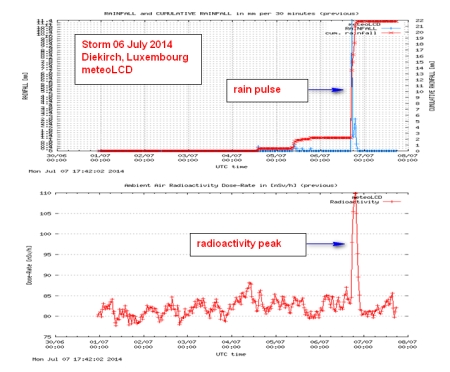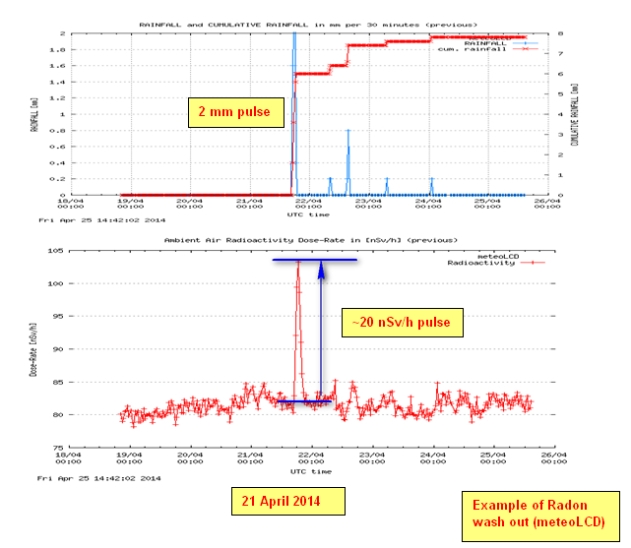See new additions at the end of the text!
Some parts of Luxembourg were under a severe storm during the late afternoon of the 6th July 2014. Wind gusts were very high (we measured a half-hour maximum of 15 m/s (54 km/h, i.e. a maximum of the average over 30 minutes) which is considerable for a location at the bottom of a valley. Our backup Vantage Pro station measured a high wind maximum of 25 m/s (90 km/h, this is an instantaneous maximum, not an average over some time interval), so no wonder that quite a lot of trees went down or lost branches. The atmospheric pressure dip (average over 30 minutes) was not spectacular: about -4 hPa (mbar), but this seems sufficient to cause very strong winds. Our lightning sensor was down, which is a pity, for we missed to record a nice storm activity. Precipitation (rainfall) peaked at about 20 mm in half an hour, and the corresponding atmospheric radioactivity surge due to radon washout was 27 nSv/h.
So lets go back to our previous discussions of radon washout (here and here) and update the graph relating radioactivity peak to precipitation pulse.
A linear fit forced through the origin is impossible: R2 = 0 ! The affine fit Rad_peak = a + b* Rain_pulse gives a slope of 0.45, i.e. every mm of precipitation pulse would increase ambient radioactivity dose-intensity through radon washout by 0.45 nSv/h. This very low value (to be compared to 7 given in the previous discussion) points to sort of a saturation effect. Let use imagine that a rain pulse of infinite intensity (hm!) would washout all radioactive radon daughters contained in a surrounding volume (a column of a certain height and a certain diameter for instance). Then a better model would be a logarithmic one, something like radon-peak = a*log(b*rain-pulse) +c, where log is the natural logarithm ( a still better model would have a horizontal asymptote). This gives indeed a better picture with a GOF of R2 = 0.29.:
In this discussion, only measurements were there is an interval of at least 3 days between the rain-pulse have been retained. The 8 Sep 2013 data point seems rather odd: may be it is the outlier spoiling a nice model!
Let’s close with a very simple model using a rational function, which has a horizontal asymptote but will not be forced through the origin:
 Hurrah: the goodness of the fit now jumps to R2 = 0.33. If the rain_pulse x tends to infinity, the rad_peak will reach the asymptotic value of 30.26 nSv/h. When the rain_pulse is zero, we should expect a radon-peak being also zero: we are close with 1.1 nSv/h.
Hurrah: the goodness of the fit now jumps to R2 = 0.33. If the rain_pulse x tends to infinity, the rad_peak will reach the asymptotic value of 30.26 nSv/h. When the rain_pulse is zero, we should expect a radon-peak being also zero: we are close with 1.1 nSv/h.
Time to leave the playground, but this amusing topic will be continued…
__________________________
Additional comments (08 July 2014):
Patrick Breuskin from the Division de la Radioprotection and a meteoLCD collaborator from time to time sent me his measurements made at 3 different locations by an AGS421 gamma counter (sampling interval = 10 minutes): AGS421_7235 is installed on the deck of meteoLCD, AGS421_7288 at the Findel airport and AGS421_7199 is measuring at Esch-Alzette. I annotated his graphs, which are shown here in the same order:
Obviously all instruments show a radiation peak coincident with the precipitation pulse. Expressed as percentages above the previous background levels, the radiation peaks are:
Diekirch meteoLCD: 33 % (baclground 83 nSv/h)
Diekirch AGS421 : 47% (54%) (background 83 nSv/h)
Findel airport: 83% (background 113 nSv/h)
Esch-Alzette: 37% (baclground 132 nSv/h)
The two Diekirch and Esch-Alzette peaks are relatively close. As the meteoLCD reading is an average over 30 minutes, one should expect lower values than the 10-minutes sampled AGS421_7235 located on the same deck. The high value of 83% at Findel airport is a bit of a surprise: as this airport is located at about 360m asl, and much more exposed to wind than the other stations. Could it be that higher wind-speeds push the radiation peaks up?
Here are the wind speed peaks rounded to the nearest integer:
Diekirch meteoLCD: 15 m/s
Findel airport: 13 m/s
Esch-Alzette: not available
These wind velocities are comparable, so wind speed does not seem to influence the relative radiation peak; neither does the background level which is highest at Esch-Alzette without yielding a higher relative radiation peak. Possibly the level of the precipitation pulse is the main factor contributing to the intensity of the radon washout. The Findel measurements are not yet available, and the closest station from ASTA is that of Merl which shows only 14.2 mm.
Well you know the tune “We need more data!”, so lets be patient.
















